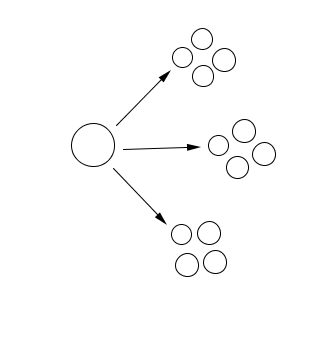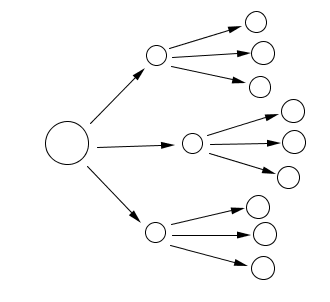Here is what my teacher and student interactions looked like when I first start teaching. Notice a problem?

The first problem was that I was overworked because I was doing ALL of the work in the classroom. The second problem was that I could only ever help one student at a time, and when I wasn’t in the middle of helping a student, they weren’t doing anything because they were waiting to be helped. Sounds like a pretty unproductive classroom if all but one of your students is off-task at any given moment.
The next thing I tried was reversing the arrows, and putting the onus on the students to ask questions when they had them. This looks something like this.

It’s slightly better than the first scenario because sometimes the students won’t ask questions (even if they need to) and you won’t feel so busy, but it still means that all of the interactions in the classroom have to go through YOU. It also results in less student engagement as they wait for their turn to ask YOU a question.
I thought about this problem, and rearranged my classes into groups.

The problem here is the same as the first example, except that I help 3 more students in my first round than before, and I get through the whole class faster. It was a bit better, and one of the things I noticed from this trial helped me design a better plan. Students naturally helped each other after I had left, so that I often could make sure that some of the people from each group got the concept, and then they would help the other students from their groups understand. It has a flaw, which also happens in the technique I tried next.

The basic premise here is, teach three students, they teach three students, and so on, until everyone understands. Quite often I’ve noticed that one student will help 4 or 5, or that a single student will be helped multiple times, etc… but basically you are distributing the work through the class. However the flaw I discovered with this technique is that I am still at the start of the process. Remove me, such as when a substitute teacher is in charge of the class, and no one can get any work done because the students don’t know where to start.
This is a little bit better.

Now at least the students will ask each other for help, and even occasionally other groups and the amount of effort you have to put into running this classroom is less. Replace the teacher, and it will almost work. It has other flaws, such as if two members of a group are absent on the same day, you have to rework your groups, and I don’t know if you’ve noticed this but stable groups during the year work a bit better. I know I’ve heard advice about switching up the groups, etc… but let’s be honest, how often do YOU switch up who you work with? About once a year right? So do the students really need practice working with different people? I’m less convinced than I used to be. This classroom has its own issues and I’m not convinced that it is really ideal either, but it is a good place to start, especially if you lack the technology to do what I suggest next.
Here is the classroom I have been building over this year, and plan to continue building for next year.

The first advantage of such a classroom is that I am no longer a central figure, and that I can be replaced in this diagram by a substitute teacher and everything will still work. The second advantage is that the students no longer have a single contact for resources. They are each nodes in an interconnected class and have the ability to self-direct their learning. The services in the centre are there to connect the students and allow a far greater variety of resources and ideas to be shared within the classroom.
As an exercise for yourself, try and create a diagram of your classroom interactions. Which classroom structure do you think works best?






